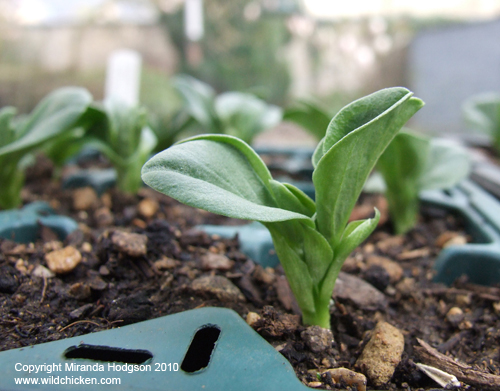The vegetable garden in April - what to do now
The soil is warming now, even our claggy Oxfordshire clay, so, having dug the garden and spread the muck, it's time to get serious about sowing vegetable seeds for a succession of fresh, crisp vegetables in the coming months. Here are some guidelines about what to do in your vegetable garden in April.
Roots such as carrots and parsnips can be sown outside and should reliably germinate. Use a hoe or a stick to draw out a long groove in the soil and sow them thinly. If the ground is dry, water the groove first Ė the seeds will stick to the damp soil and will be less likely to blow away if itís a windy day. Cover the seeds over and pat the soil firm over them. Donít forget to label the row and make a note of the date you sowed the seeds. The plants may need to be thinned out once they reach about 3cm high but, to prevent carrot fly smelling them, wait until they have reached this size. That way, you can pull them out in one go without leaving any bits behind that the flies would smell and zone in on. Finding carrot fly maggots tunnelling through your prized crop is a real let-down.
If carrot fly is a problem where you live, covering the crop with a fine horticultural fleece will protect the crop. It isn't very nice to look at, but at least you'll have undamaged carrots and parsnips.

Martock broad bean
If you are planning on growing sweet corn or tomatoes in the ground, covering the soil with black plastic now will warm it up nicely so that when the plants are big enough to go outside, they wonít go into chilly ground, which would slow them down again. If your plants have been in a greenhouse, harden them off for a few days by leaving them outside in a sheltered spot during the day.
If youíve bought a couple of tomato plants, or donít have many plants started, you can very easily take cuttings and bulk up your plant numbers considerably. Itís so easy and satisfying - Iíll go into this next month when the plants are bigger.
Plant out the rest of your onions now, if they havenít yet gone in the ground. Raking in an organic all-purpose plant food beforehand will help them get going Ė use about 70g to the metre. Water them once a week in dry weather.
Finish planting out your potatoes. If they havenít yet chitted, remember that commercial growers donít plant chitted potatoes because the sprouts would all fall off in the machinery during planting. The potatoes grow anyway. Earth up when the foliage reaches about 20cm/8 inches high, or if frost threatens.
Indoor sown beans and peas are now breaking the soil surface and putting out their first leaves and I aim to start another batch off at the end of April so that we donít end up with a huge glut all at once. I plant indoors partly for the extra warmth, as I donít have a heated greenhouse, and to safeguard against hungry mice, who can detect them easily with their fine sense of smell and will dig them up and eat them as soon as my back is turned. These young plants will be potted on when they reach about 7cm/3 inches high.
Salad seedlings
Vegetables that can be started now, in the ground, from seed
Cabbages, Chinese leaf, Pak Choi and other Oriental greens, leeks, spinach, lettuce, chard, radishes, swedes, endive, spring onions, cauliflower, calabrese, kohl rabi, turnips.
Vegetables to start now under cover
Courgettes, squashes, herbs, aubergines, French and runner beans, sweet corn, tomatoes, celeriac, cucumbers, kale, endive, sprouting broccoli, celery.
Things to watch out for
Slugs and snails will be sliming their way towards your tender young seedlings Ė go out after dark with a torch and pick them off by hand (people might think youíre a bit strange, but theyíre probably not the ones looking forward to lovely home-grown vegetables on the dinner table), use beer traps or nematodes, which can be bought from garden centres and watered into the soil. Encourage birds, hedgehogs and amphibians by putting out dishes of fresh water, which are a magnet for wildlife.
If your vegetable garden is open, consider putting up fencing to deter deer, rabbits and sweet-toothed badgers. Badgers adore ripe sweet corn and will travel to it. When they find it, theyíll lay waste to the whole crop.
Weeds! Hoe regularly, especially on dry days, to keep them under control so they donít compete with your vegetables for water, nutrients and light. Weeds like bitter cress and shepherdís purse are hosts for club root, which affects cabbages and other members of the brassica family, so try to spot them and hoe them off.
Words of hope for new gardeners
Plants have been growing on this planet for many millions of years Ė they want to grow. Since the dawn of time, they have been trodden on, slept upon, uprooted, chewed up and spat out and the planet is still green with growing things. Mistakes will always be made but, more often than not, unless they die of thirst or serious disease, the plants will grow.
© Copyright Miranda Hodgson 2010
